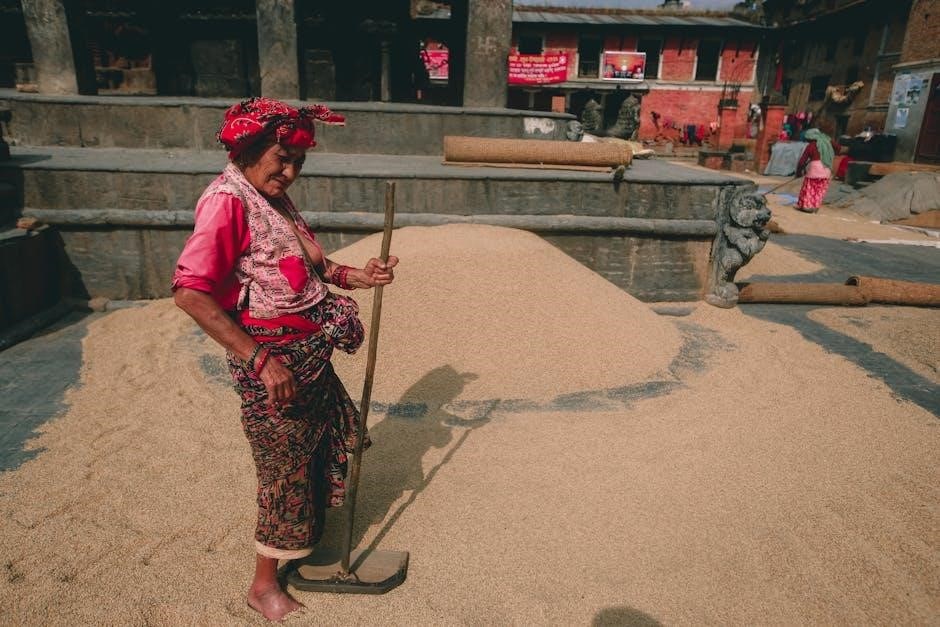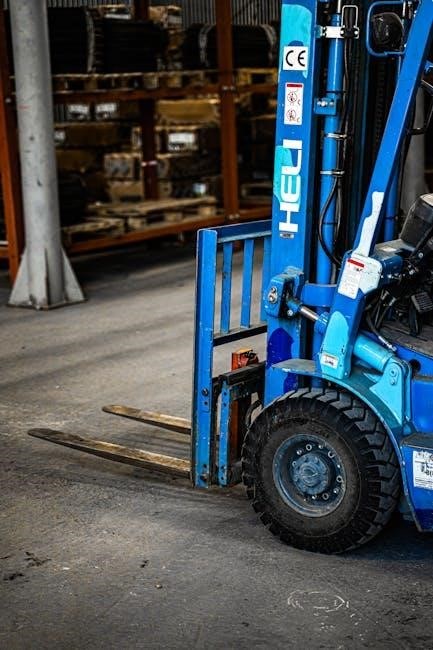TILE stands for Task, Individual, Load, and Environment, a framework used in manual handling to assess risks and prevent injuries by evaluating these four key factors․
What is TILE in Manual Handling?
TILE is an acronym standing for Task, Individual, Load, and Environment․ It is a framework used to assess and mitigate risks in manual handling tasks․ The Task refers to the specifics of the activity, such as movements and physical demands․ The Individual considers the person’s capabilities, like strength and training․ The Load involves the object’s characteristics, such as weight and stability; The Environment examines workplace conditions, including layout and hazards․ This comprehensive approach helps identify potential hazards and implement safety measures, enhancing workplace safety and reducing injury risks․
Importance of TILE in Workplace Safety
The TILE framework is crucial for ensuring workplace safety by systematically identifying and mitigating risks in manual handling tasks․ By focusing on Task, Individual, Load, and Environment, it provides a comprehensive approach to assess potential hazards․ This method helps employers and employees understand the specific risks associated with each task, enabling proactive measures to prevent injuries․ TILE promotes a structured evaluation process, ensuring that all factors contributing to manual handling risks are considered․ Its application leads to safer work practices, reduced injury rates, and improved overall workplace safety standards․ Regular use of TILE fosters a culture of safety and compliance, benefiting both employees and organizations․

Task
The Task component involves a comprehensive analysis of the manual handling task, examining specifics like required movements and postures to identify potential risks and demands․
Understanding the Task in Manual Handling
Understanding the task involves examining the specific actions and movements required to complete a manual handling activity․ This step identifies the nature of the work, such as lifting, carrying, or pushing, and assesses the forces and postures involved․ It also considers the frequency and duration of the task, as repetitive movements can increase injury risks․ By breaking down the task into its components, employers and workers can pinpoint potential hazards and determine whether the activity is within a person’s capabilities․ This analysis is crucial for designing safe work processes and reducing the likelihood of musculoskeletal disorders․ Proper task understanding ensures that manual handling is performed efficiently and safely, minimizing risks to individuals․
Analyzing Task Requirements

Analyzing task requirements involves evaluating the physical and mechanical demands of a manual handling activity․ This includes assessing the forces exerted, postures adopted, and repetitive movements․ It also considers the task’s frequency, duration, and the workspace layout․ Understanding these factors helps identify potential risks and opportunities for improvement․ Tools like task analysis checklists or software can aid in breaking down complex tasks into manageable components․ By pinpointing specific demands, employers can implement ergonomic adjustments or redistribute workloads․ This step ensures tasks are designed to match human capabilities, reducing the risk of injury and enhancing productivity․ Effective task requirement analysis is essential for creating a safer and more efficient work environment․
Identifying High-Risk Movements
Identifying high-risk movements in manual handling involves pinpointing actions that pose the greatest threat of injury․ These movements often involve repetitive strain, awkward postures, or excessive force․ Examples include lifting from the floor, twisting, or reaching overhead․ Assessing these movements helps prioritize interventions to reduce injury risks․ Observing workers and analyzing task patterns can reveal high-risk actions․ Tools like motion analysis or risk assessment checklists can aid in identification․ Addressing these movements through ergonomic adjustments or alternative methods can significantly lower injury rates․ Early identification fosters a proactive approach to workplace safety, ensuring tasks are redesigned to minimize hazards and protect workers’ well-being․ This step is crucial for preventing musculoskeletal disorders and promoting a safer work environment․

Individual
Assessing individual capabilities ensures tasks align with a worker’s physical limits․ Physical attributes, health factors, and prior training reduce injury risks and enhance efficiency․
Assessing Individual Capabilities
Assessing individual capabilities involves evaluating a worker’s physical and mental strengths to ensure tasks are within their safe working limits․ This includes considering factors like muscle strength, endurance, and flexibility․ By aligning tasks with personal abilities, the risk of overexertion and injury is minimized․ Employers must also account for any physical limitations or health conditions that may impact performance․ This assessment ensures that workers are assigned roles that match their capabilities, promoting both safety and productivity․ Regular evaluations help maintain a safe working environment and prevent potential harm․ Ultimately, understanding individual differences is key to creating a workplace where tasks are manageable and risks are controlled effectively․
Physical Attributes and Health Factors
Physical attributes and health factors play a crucial role in manual handling safety․ An individual’s body size, strength, and flexibility can significantly influence their ability to perform tasks without injury․ Health conditions, such as back problems or chronic pain, must also be considered․ Poor physical health or pre-existing injuries can increase the risk of harm during manual handling tasks․ Employers should evaluate these factors to ensure workers are suited for their roles․ Properly matching tasks to physical capabilities helps reduce injury risks and improves overall workplace safety․ Addressing health factors early can prevent long-term disabilities and create a safer, more inclusive work environment for all employees․
Role of Training and Experience
Training and experience are essential for safe manual handling practices․ Proper training equips individuals with the knowledge and skills to perform tasks correctly, reducing injury risks․ Experienced workers often develop techniques that minimize strain, while newcomers may lack awareness of proper methods․ Regular updates and refreshers ensure workers stay informed about best practices․ Employers should provide comprehensive training programs tailored to specific tasks, emphasizing proper lifting techniques, posture, and load management․ Experience enhances judgment, allowing workers to assess tasks more effectively and adapt to challenges․ Combining training with practical experience fosters a culture of safety, empowering individuals to handle loads confidently and responsibly․ Continuous learning and skill development are key to maintaining a safe and efficient workplace environment․

Load

The load refers to the object or material being moved․ Understanding its weight, size, shape, and stability is crucial for safe manual handling․ Proper handling techniques ensure safety and efficiency, reducing injury risks and damage to the load․ Assessing the load’s characteristics helps determine the best approach for lifting, carrying, or lowering, ensuring it is manageable within individual capabilities and environmental conditions․ Effective load management is vital for preventing workplace accidents and maintaining productivity․
Characteristics of the Load
The characteristics of the load are critical in manual handling assessments․ Weight, size, shape, and balance are key factors․ A load’s stability, texture, and temperature can also impact handling․ Understanding these traits helps determine the safest lifting techniques․ For example, uneven or unstable loads may require additional support or equipment․ The size and shape of the load influence grip and control, while weight distribution affects lifting posture․ Loads with sharp edges or hazardous materials demand extra precautions․ Assessing these characteristics ensures that handlers can manage the load safely, reducing the risk of injury or damage․ Proper evaluation of load characteristics is essential for effective manual handling practices․ It also helps in selecting appropriate tools or assistance when needed․
Weight and Size Considerations
Weight and size are fundamental factors in manual handling․ Excess weight increases strain, while oversized loads can obstruct visibility and control․ Loads exceeding recommended limits pose significant injury risks․ Size considerations include dimensions that may hinder movement or balance․ Handling bulky or heavy objects requires precise planning and techniques․ Weight distribution is equally important; unevenly distributed loads can cause instability․ Assessing the load’s weight and size helps determine if additional support, equipment, or assistance is needed․ Proper measurement and evaluation ensure tasks are manageable within safety guidelines․ These considerations prevent overexertion and reduce the likelihood of accidents․ Regular training on weight and size assessments enhances workplace safety and efficiency․ Balancing these factors is crucial for safe manual handling practices․ Adherence to these guidelines minimizes risks and promotes a healthier work environment․ Effective weight and size management is vital for overall operational safety․
Load Handling Techniques
Proper load handling techniques are essential to minimize strain and injury risks․ The stoop, squat, and leg lift methods are commonly recommended․ The stoop involves bending at the waist, while the squat uses knee bending to lower the body․ Lifting with leg power rather than back strength is crucial․ For heavy loads, teamwork or mechanical aids like trollies or slings should be used․ Maintaining a firm grip and keeping the load close to the body reduces instability․ Twisting should be avoided; instead, pivot on the feet․ Proper posture and balanced lifting techniques ensure control and stability․ Regular training on these methods enhances safety and efficiency․ Implementing these techniques reduces workplace injuries and improves overall handling practices․ Safe load handling is a cornerstone of effective manual handling strategies․ Consistent practice and adherence to these techniques are vital for long-term safety․

Environment
Evaluating the workspace layout, flooring, and equipment is crucial․ A well-organized environment reduces obstacles, while suitable flooring prevents slips․ Proper tools and equipment enhance safety and efficiency․
Evaluating the Workspace Layout

Evaluating the workspace layout involves assessing how the physical arrangement of the environment impacts manual handling tasks․ It considers the distance between workstations, accessibility of items, and presence of obstacles․ A well-designed workspace minimizes unnecessary movements and reduces the risk of accidents․ Factors such as pathway clearance, storage positioning, and workflow efficiency are critical․ Poor layout can lead to prolonged bending, reaching, or twisting, increasing the strain on workers․ By optimizing the workspace, employers can enhance productivity and reduce the physical demands on employees; Regular assessments ensure the environment remains safe and functional, aligning with ergonomic principles to prevent injuries and improve overall task performance․
Impact of Flooring and Surfaces
The impact of flooring and surfaces plays a significant role in manual handling safety․ Slippery or uneven surfaces can increase the risk of accidents, such as slips, trips, or falls․ Flooring conditions, including cleanliness, texture, and evenness, directly affect stability during tasks․ Proper footwear and floor maintenance are essential to prevent hazards․ Additionally, surfaces that are poorly maintained or cluttered can obstruct movement, forcing workers to adopt awkward postures or paths․ Regular inspections of flooring and surfaces are critical to identify and address potential risks․ Ensuring surfaces are stable, clean, and free from obstructions minimizes the likelihood of incidents․ This creates a safer environment for employees, reducing the physical and mental strain associated with unsafe conditions․
Role of Equipment and Tools
The role of equipment and tools in manual handling is crucial for ensuring safety and efficiency․ Properly designed tools, such as lifting aids, hoists, and mechanical assistants, can significantly reduce physical strain․ Equipment like trolleys, dollies, and conveyors help minimize manual effort, lowering the risk of injury․ Well-maintained tools ensure reliability, while ergonomic designs align with worker capabilities, enhancing comfort and reducing fatigue․ Training on the correct use of equipment is essential to maximize safety benefits․ Additionally, the right tools can streamline tasks, improving productivity and reducing workplace accidents․ Regular maintenance and updates to equipment are vital to sustain a safe working environment․ By leveraging appropriate tools, businesses can create a safer, more efficient manual handling process․

Best Practices
Implementing TILE in daily operations ensures a structured approach to manual handling․ Regular risk assessments and proper training are essential for maintaining a safe workplace environment․
Implementing TILE in Daily Operations
Implementing TILE in daily operations involves a proactive approach to manual handling safety․ Begin by assessing tasks to identify and reduce high-risk movements․ Ensure individuals are physically capable and properly trained for their roles․ When handling loads, always consider weight, size, and stability, using appropriate lifting techniques․ The environment plays a crucial role, so maintain a clean, obstacle-free workspace and use ergonomic equipment․ Regular training sessions and workplace audits can reinforce TILE principles․ Encourage employees to report hazards and suggest improvements, fostering a culture of safety․ By systematically applying TILE, organizations can significantly reduce injury risks and promote a safer, more efficient working environment;

Regular Risk Assessments
Regular risk assessments are essential for maintaining a safe working environment and ensuring the effective implementation of TILE principles․ These assessments should be conducted periodically to identify potential hazards in manual handling tasks․ By observing how tasks are performed and consulting with employees, organizations can gain insights into recurring risks․ Data from these assessments helps prioritize interventions, such as modifying workflows or providing additional training․ Regular reviews also ensure that changes in the workplace, like new equipment or updated procedures, are evaluated for safety․ This proactive approach reduces the likelihood of injuries and improves overall efficiency․ By integrating risk assessments into routine operations, organizations can sustain a culture of safety and continuous improvement, ultimately protecting both employees and the business․


